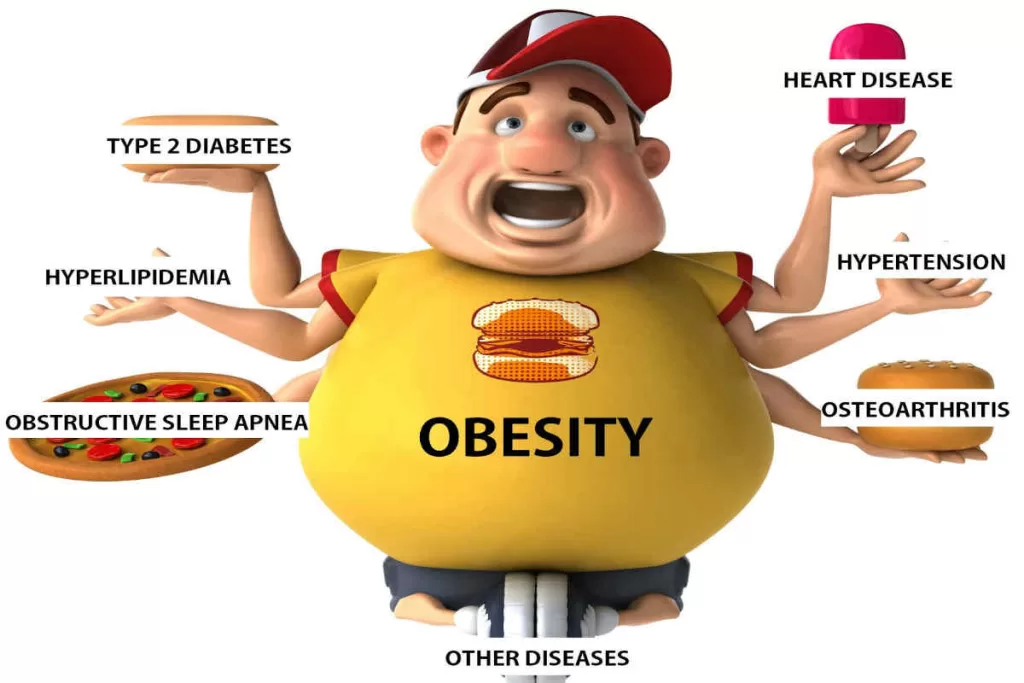Obesity is a medical condition brought about by an excessive accumulation of body fat. However, it is to the extent that it may Increase the risk of diseases and health problems such as high blood pressure, heart disease, and diabetes.
So, BMI is calculated by measuring the average body weight against the average body height. The BMI range is as follows:
- Normal 18.5 -24.9
- Overweiht 25 – 29.9
- Obesity 30 and above.
Causes of obesity.
Occurs when one consumes too many calories than what the body needs thus the excess is stored as fat. Other causes may be due to:
- Genetic.
- Metabolic.
- Behavioral.
- Hormonal influence.
Signs of obesity.
- Joint and back pain.
- Increased sweating.
- Also, Snoring.
- Body fatigue.
- One easily gets tired during any physical activity.
- Low self-esteem.
Risk factors for obesity.
There are a number of contributions that can lead to one being obese. They include:
- Family history.
- Lifestyle choices – are divided into two:
- A poor diet is where one consumes food rich in calories e.g. fast foods.
- No exercise- especially where one’s job involves sitting down for long hours.
- Medical conditions and medication e.g. Cushing syndrome. Medications such as diabetes drugs, steroids, and anti-depressants can lead to one gaining weight if physical activities are limited.
- Age- as one year’s increases tend to increase it’s advisable for one to be physically active.
- Depression.
- Pregnancy.
- Social isolation.
- Low self-esteem.
- No cigarette smoking.
- Disability.
- Microbiome.
Complication.

- Digestive problems e.g. heartburn, and gall bladder disease in obese individuals.
- Heart diseases are due to high blood pressure and abnormal cholesterol levels.
- Developing diabetes, especially type 2 diabetes as obesity interferes with insulin utilization in the body.
- Certain cancer e.g. breast, cervical, and pancreas cancer development is high in obese individuals.
- Osteoarthritis- where too much pressure is exposed to joints thus leading to inflammation.
- Sleep apnea- repeated breathing stops and starts during sleep.
Diagnosis.
- Physical examination- height, blood pressure, and heart rate measurement is done.
- BMI calculation- helps to show if one is overweight or not.
- Waist circumference measurement- Fat deposits in the waist region poses a risk to obesity.
- Health history taking- to assess if one is predisposed to a certain condition.
Treatment.
- Diet change- eating more vegetables and fruits rather than fast foods.
- Behavior change- e.g. counseling for those with low self-esteem, depressed individuals.
- Bariatric surgery also known as weight loss surgery- food absorption is decreased. Common weight loss surgery includes:
- Gastric sleeve- part of the stomach is removed leaving a small food reservoir is left.
- Gastric bypass surgery- where a small pouch is created at the top of the stomach.
- Adjustable gastric banding- an inflatable band is used to separate the stomach into two pouches.
- Vagal nerve blockage – a device implanted under the skin of the abdomen and used to inform the brain when to feed.
- Gastric aspirate- a tube is placed through the abdomen to the stomach and some stomach contents are drained after a meal.
- Xhydrogels- are edible capsules that have tiny particle which absorbs water. The capsules are taken before meals and passed away in the stool.
- The best private primary schools in Nyeri county.
- Egerton university, fees, location, courses.
- List of Best private secondary schools in Nairobi County.
- List of Accredited Private Universities in Kenya
- What is the history of Kenyatta University?
- Kenya Medical Training College, courses, requirements.
- List of best private primary schools in Kirinyaga County.